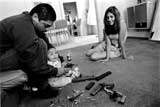Gun Control
During John Hinckley's 1981 assassination attempt, a bullet intended for Ronald Reagan struck Press Secretary James Brady in the head, leaving him disabled. Although Brady and his wife Sarah were Republicans, they became staunch advocates for restrictions on gun purchasing and ownership. It isn't until 1993, under a Democratic president, that the Brady Handgun Violence Prevention Act becomes law. The bill institutes a mandatory five-day waiting period for handgun buyers so that a background check can be performed before they receive their weapons. It requires firearms dealers to register with the federal government and bars them from selling guns to convicted felons, anyone awaiting felony charges, or fugitives. The next year, the Violent Crime Control and Law Enforcement Act bans the manufacture of 19 types of assault weapons.
The federal government now has an unprecedented level of control over weapons, and many people support even more restrictions. However, although the public agrees that gun violence is unacceptable, there are many who don't support government intervention. The National Rifle Association argues that the Second Amendment guarantees the right to bear arms, making laws like the Brady Bill are unconstitutional. Many add that criminals don't necessarily purchase their guns legally, and that controls only disarm the "good" guys. Some groups support a licensing system similar to that used by motor vehicles departments. The debate is still raging at the end of the decade. By then, gun manufacturers have become targets for litigation holding them responsible for crimes perpetrated with their weapons.
 |
| Mother, Father, and Child with Gun Joseph Rodriguez, 1993 |